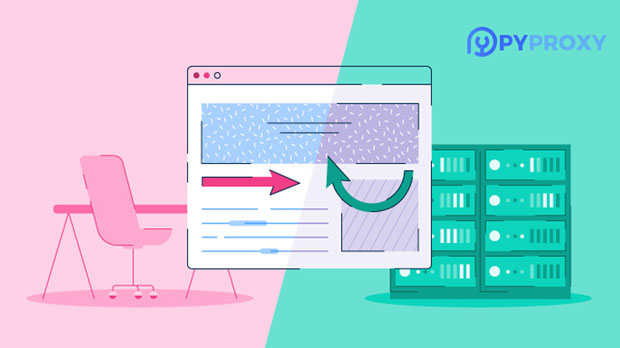When it comes to utilizing proxies in the digital world, flexibility, efficiency, and reliability are key factors. Two major options available for users seeking dynamic proxy pools are PYPROXY and Extratorrents Proxy. Both offer dynamic proxy solutions, but they differ in terms of flexibility, scalability, and overall user experience. In this article, we will delve into the comparison of these two proxy services, focusing on their dynamic proxy pools. By evaluating the features, performance, and real-world applications of each service, this article aims to provide practical insights that will help users determine which option is more suitable for their needs. Understanding Dynamic Proxy PoolsBefore comparing PyProxy and Extratorrents Proxy, it's important to first understand what a dynamic proxy pool is and how it works. A dynamic proxy pool refers to a collection of proxy servers that can rotate IP addresses automatically to ensure seamless browsing or scraping tasks. Dynamic proxies are especially valuable for tasks that require anonymity, such as web scraping, data mining, and managing multiple accounts, as they help in preventing detection or blocking by websites. These proxies are often used in scenarios where IP rotation is necessary to maintain a consistent flow of traffic without being flagged for suspicious activity.PyProxy: Key Features and FlexibilityPyProxy is known for its robust features and ease of use, offering a dynamic proxy pool that can cater to various needs. The flexibility of PyProxy lies in its ability to provide multiple proxy types, including residential proxies and data center proxies. This mix allows users to tailor their proxy pool to the specific needs of their tasks. Here are some aspects that contribute to PyProxy’s flexibility:1. Wide Range of Proxy Types: PyProxy supports residential, data center, and mobile proxies. Residential proxies provide real user IP addresses, making them harder to detect and block. Mobile proxies, on the other hand, offer IP addresses from mobile devices, which are particularly useful for bypassing mobile device restrictions. 2. Easy Integration: PyProxy offers seamless integration with various automation tools, making it easier for users to set up and manage their proxy pools for different use cases. This feature is particularly helpful for users who need to integrate proxy management with their existing systems.3. Advanced IP Rotation: The automatic rotation of IP addresses is one of the key advantages of PyProxy. Users can set up custom rotation intervals, ensuring that IP addresses change frequently to avoid detection. This feature is especially useful for tasks that require large-scale scraping or data collection.4. Geolocation Control: PyProxy allows users to choose proxies from specific regions or countries. This level of control is beneficial for tasks that need to access location-specific content or services.Extratorrents Proxy: Key Features and FlexibilityExtratorrents Proxy also provides a dynamic proxy pool, but it operates somewhat differently than PyProxy. While the core features of both services are similar, Extratorrents Proxy offers a more focused approach to handling proxies for specific applications. Let’s explore the key features that define the flexibility of Extratorrents Proxy:1. Specialized Proxy Pools: Extratorrents Proxy tends to focus more on specific use cases, such as torrenting or bypassing geo-restrictions for media streaming. The proxy pool is tailored for high-speed, high-volume traffic, which is ideal for users who need proxies for media-related tasks.2. Speed and Performance: One of the standout features of Extratorrents Proxy is its emphasis on speed. Users looking for fast and reliable proxy services for high-bandwidth applications will find Extratorrents Proxy to be a good fit.3. Proxy Rotation and Anonymity: Like PyProxy, Extratorrents Proxy offers automatic IP rotation, ensuring anonymity and preventing IP bans. However, its rotation capabilities are designed to cater to users who require continuous high-speed connections.4. Easy Setup for Specific Tasks: Extratorrents Proxy provides an intuitive interface for users to set up proxies for specific tasks, making it easy to configure proxies for one-off use cases, such as bypassing restrictions or torrenting.Comparison: Which Service Offers Greater Flexibility?Now that we have explored the individual features of PyProxy and Extratorrents Proxy, let's compare them based on flexibility:1. Proxy Variety: PyProxy offers a broader selection of proxy types (residential, data center, and mobile), providing users with more options to suit different needs. This variety makes PyProxy more versatile when it comes to catering to different tasks, such as web scraping, account management, or accessing geo-restricted content. On the other hand, Extratorrents Proxy focuses on providing proxies for specific, high-speed use cases, particularly in the media streaming and torrenting domains.2. Customization: PyProxy stands out in terms of customization. Users can configure rotation intervals and select proxies based on geographical locations, giving them more control over their proxy pool. Extratorrents Proxy, while offering proxy rotation and speed, does not provide as much control over customization options. This makes PyProxy the more flexible option in terms of tailoring proxies for different applications.3. Ease of Use: Both services offer user-friendly interfaces, but PyProxy’s integration with automation tools and broader support for different use cases makes it a more flexible choice for users who need to manage proxies for various tasks. Extratorrents Proxy, while easy to use, is more specialized and may not offer the same level of flexibility for users with diverse requirements.4. Performance and Speed: While both services ensure that proxies rotate automatically to prevent detection, Extratorrents Proxy excels in providing high-speed proxies for media-heavy applications. PyProxy, however, offers a better balance of performance across various tasks, making it more adaptable for users with multiple use cases.Real-World Applications and Use CasesTo fully appreciate the flexibility of PyProxy and Extratorrents Proxy, it's essential to consider real-world applications:1. PyProxy: Best suited for users involved in large-scale web scraping, SEO, data collection, or automation tasks that require a variety of IP types. Businesses or developers who need to perform multiple functions (e.g., scraping, account management, or location-based services) will benefit most from PyProxy’s flexibility.2. Extratorrents Proxy: Ideal for users focused on high-speed, media-related tasks such as torrenting or streaming. The proxies provided by Extratorrents Proxy are optimized for performance in these areas, making it an excellent choice for users who prioritize speed and reliability in their connections.In terms of flexibility, PyProxy takes the lead, offering a broader selection of proxy types, advanced customization options, and more use-case versatility. However, Extratorrents Proxy is still a solid choice for those who need specialized proxies for high-speed media applications. Ultimately, the decision depends on the specific requirements of the user—whether they need a dynamic proxy pool for general-purpose tasks or a more specialized service for media-related activities.
Sep 02, 2025



































































